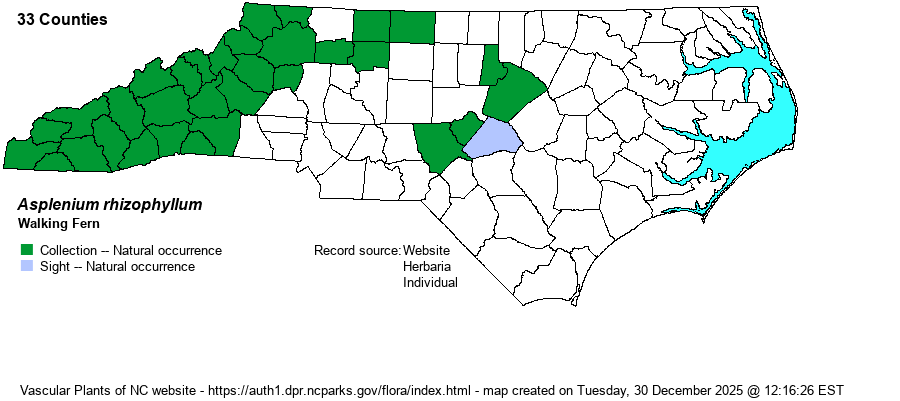| Author | L. | |
| Distribution | Throughout the Mountains; scattered in the upper Piedmont near the Mountains, and disjunct to the Fall Line area of the far eastern Piedmont (Deep River, Eno River).
This is a rather widespread species of the Northeastern part of the continent, ranging from eastern Canada south to northern GA and eastern OK, mainly scarce in the Piedmont and nearly absent from the Coastal Plains. | |
| Abundance | Infrequent to fairly common in the Mountains; uncommon in the northwestern Piedmont, and rare along the Fall Line. Essentially absent over most of the central and eastern Piedmont. Though found in 33 counties, at a minimum, and all montane ones, the S3 rank as assigned by NCNHP does seem to be reasonable, owing to the somewhat limited sites available to it. | |
| Habitat | This species grows essentially on rocks and ledges, rarely on tree bases. Like many in the genus, it is restricted to calcareous or mafic rocks, always where shaded and typically somewhat moist/damp. However, this plant often grows on horizontal or slanted surfaces and crevices, and not strictly on near-vertical ones like many species. It often grows in moss on the rocks. | |
| Phenology | Fruits from May to October. | |
| Identification | This is a very distinctive fern, familiar to most biologists in the western part of the state, but hard to find in the eastern half. Several fronds grow from a base, with each stipe being about 3" long, with a dark brown base but green otherwise. The evergreen blade is very narrowly lanceolate with a long, linear tip, being about 6-7" long but only 1" wide or less at the base. The margins are entire (not lobed), other than a basal lobe on each side of the stipe. Sori are very numerous on the underside of the blade, diagonal to the midrib. Only A. pinnatifidum is remotely similar in NC, but that species has distinctive rounded lobes on the lower third to half of the blade, and it grows essentially on felsic rocks (such as schist or sandstone). Interestingly, this species often roots from the tip of the blade (where it contacts moss or soil matter), a new plant developing from that spot. | |
| Taxonomic Comments | Older references often placed the species in another genus, as Camptosorus rhizophyllus.
| |
| Other Common Name(s) | Walking Spleenwort | |
| State Rank | S3 | |
| Global Rank | G5 | |
| State Status | | |
| US Status | | |
| USACE-agcp | | |
| USACE-emp | | |

